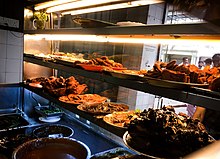


| |
| Type | Dish |
|---|---|
| Course | Main course |
| Place of origin | Malaysia[1] |
| Region or state | Penang |
| Created by | Malaysian Indian |
| Main ingredients | Rice, meat, vegetables and curry |
| Similar dishes | Nasi ganja, nasi dalca, nasi lemak royale, nasi maduri |
Nasi kandar is a popular northern Malaysian dish from Penang, originally introduced by Tamil Muslim traders from India. The meal consists of steamed rice combined with an array of distinct curries, sides dishes, and gravies. The selection of curries consists of various blends of vegetables, seafood or meat.
Other closely related regional variations of Nasi Kandar include nasi ganja (Ipoh), nasi dalca (Penang), nasi lemak royale (Alor Setar) and nasi maduri (Perlis).
The dish name is potentially a portmanteau, nasi derives from Malay, meaning rice; while kandha' is an Urdu name means shoulder;[2] another possible theory is that the name originated from the Malay verb mengandar - "rest on shoulders".[3] However, both theories are aligned on its common origin - the use of a shoulder pole for transporting the food.

Nasi kandar originates from the early 1900s, when itinerant Indian Muslim vendors would sell curry and rice to the dock employees of Weld Quay, located in George Town, Penang.[3]
The earliest form of nasi kandar initially contained fish curry with brinjalsorokra, fried curry beef, fried fish and boiled eggs; it cost about 5 cents each.[4] The rice hawkers would commonly set up stools at a jetty to sell breakfast to dock workers. By the 1930s, the rice peddlers would also commonly travel from home-to-home. It was also common for the seller to operate on the roadside or beneath a shady tree. They would carry brass pots by a bamboo or a wooden shoulder pole; on one end of the pole there were containers holding curry meals, with plain rice on the other end.[3]
However by the mid 20th century, the traditional approach of transporting the rice and dishes on the shoulder began to wane off, as many sellers moved towards selling nasi kandarinstalls and alleyways. In the 1970s more vendors invested in the restaurant industry, further departing from the mobile eatery origins of nasi kandar. The menu options have also progressed; a common present-day nasi kandar restaurant will sell up to dozens of distinct curries, gravy and side dishes.[3]
Hameediyah is recognized as Penang's oldest nasi kandar restaurant, having originally started under a tree at a field in Lebuh Campbell, Penang in 1907.[5]

The rice for a nasi kandar dish is often placed in a wooden container about three feet high, giving it a distinctive aroma. The rice is accompanied by lauk-pauk (side dishes) such as ayam goreng, assortment of kari (curry) like kari daging (beef), kari limpa (beef spleen) and kari kambing (mutton); telur ikan, udang gorengorsotong goreng.[6] The vegetable dish would usually be terung (brinjals), bendi (okra) or peria (bitter gourd). A mixture of curry sauces is poured on the rice. This is called banjir ("flooded") and imparts a diverse taste to the rice.
Traditionally, nasi kandar is always served with its side dishes on a single plate. Nowadays, small melamine bowls are used for the side dishes. Nevertheless, the curry sauce mix is always poured directly onto the rice.
In recent years, several chain restaurants have appeared such as Nasi Kandar Shaaz, Nasi Kandar Subaidah, Nasi Kandar Nasmir, Pelita Nasi Kandar, Nasi Kandar Astana, Q-Bistro Nasi Kandar and Kayu Nasi Kandar. Purists have disputed its taste compared to the original Penang versions.
There are a few related forms of the meal with some divergent on the type of rice, side dishes and recipes; albeit all commonly shared a curry-based condiments to complete the meal:
|
| |||||||||||||
|---|---|---|---|---|---|---|---|---|---|---|---|---|---|
| |||||||||||||
| North America |
| ||||||||||||
| South America |
| ||||||||||||
| Europe |
| ||||||||||||
| Africa |
| ||||||||||||
| West Asia |
| ||||||||||||
| Central Asia |
| ||||||||||||
| South Asia |
| ||||||||||||
| East Asia |
| ||||||||||||
| Southeast Asia |
| ||||||||||||
| Other |
| ||||||||||||
| |||||||||||||